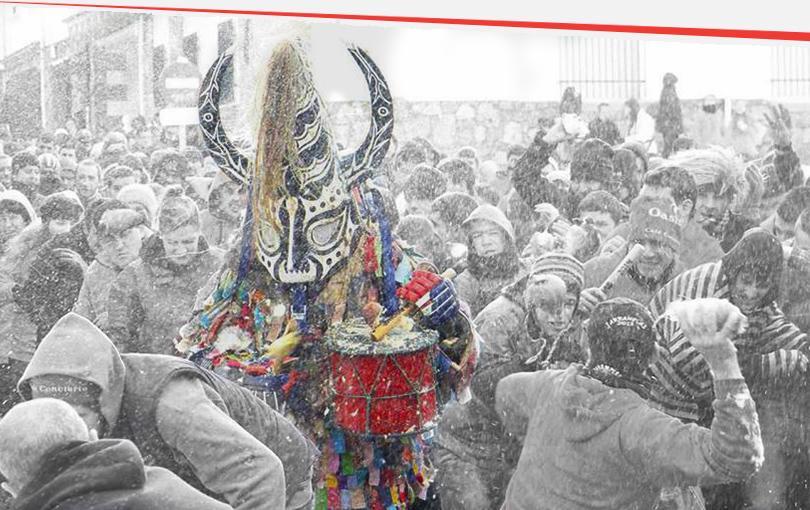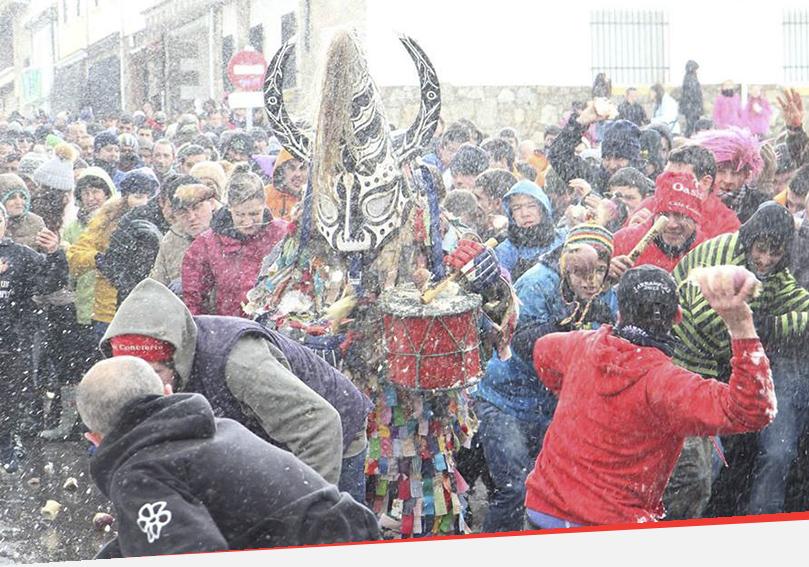Piornal
Fiesta of Jarramplas
Jarramplas. Fiesta of National Tourist Interest. Piornal (Valle del Jerte)
Jarramplas is a festival that takes place on January 19 and 20 in the Extremadura town of Piornal, the highest town in all of Extremadura. Since December 2014 it has been declared a "Fiesta of National Tourist Interest".
Jarramplas is a term that gives name to the fiesta but also the main character of it. Jarramplas is a character who, dressed in a mask and a suit of multicolored ribbons, goes down the streets of Piornal playing the tamboril (that's what piornalegos call their drums) while people throw him turnips.
Piornal, every year by Jarramplas, receives thousands of tourists and visitors interested in this peculiar fiesta. Each year Jarramplas gets more present in the media. Regional, of course (Canal Extremadura, Cadena Ser Cáceres, etc) as well as National (España Directo, Repor, Aquí la Tierra, Onda Cero Madrid...) but also International: for example this year we have received televisions from the United States, Australia, Germany, Italy .. but also in 2014 an important public television program from Japan came to Piornal to do a wide report about Jarramplas. As a curiosity, on a screen of the subway in Tokyo, the Japanese capital, a video of our most important fiesta is projected.
Although Jarramplas is a fiesta and such an important figure in the town, it is also a main theme in different areas: a doctoral thesis on Jarramplas has been made by an anthropologist; several musical groups, both local and regional and national have played songs with Jarramplas as a main character, ACETRE, with his "Alborada de Jarramplas, for example. In one of the main squares of the town of Piornal a statue of Jarramplas made by piornalegos artists has been installed; one of the "painted façades of Piornal" (the open air museum project) depicts Jarramplas and, above all, the Museum of Jarramplas, a modern and interactive space that has been dedicated to Jarramplas.

Jarramplas - Piornal
Fiesta of National Tourist Interest
CLOTHING OF JARRAMPLAS
The mask:
It has a conical shape and is characterized by its two horns, one on each side, its prominent nose and its teeth and fangs that make cause fear. From the top vertex hangs hair of horsehair and horsetail that moves with the movements of Jarramplas.
Each year six masks are made that go out in the streets during the two days of the fiesta: on the 19th, to remove the weight of the official Jarramplas, his friends and family dress up from Jarramplas. But on the 20th, the big day of the fiesta, only the one who is the official Jarramplas of that year get dressed, and as such, he has his own mask that only he puts on.
The masks are usually painted by the friends and relatives of Jarramplas. The technique and motives are free, there is no rule that says how a mask should be painted, but it is true that the most usual are the traditional ones: formerly they were painted with animal blood, with olives, with mud, earth, clays etc ... and these colors are the most used.
The material used for the masks is now fiberglass. Beforehand they were made of cardboard, but in 1992, as people were throwing more and more turnips, and Jarramplas was bruised because of the blows, they began to use fiberglass and it is currently used. Each mask weighs between 12 and 14 kilos.
The masks are made by the mayordomos (butlers), a very important and indispensable figure in the fiesta. Each Jarramplas has its own butlers that can vary in number (on the year 2017 there were 29, while other year there were only 2). They are the ones who take care of organizing and paying for the whole fiesta. Except for the turnips and the posters (this is the city council) the butlers pay everything else: about 10,000 euros.
The suit of ribbons:
Jarramplas wears a suit made up of a top and trousers to which many ribbons of different colors are sewn.
The women in charge of making the costume are the women around Jarramplas: mother, wife, girlfriend, sisters, sisters-in-law, butlers...
From fabrics and old clothes, ribbons are cut and sewn one by one. Each suit wears around 3000 multicolored ribbons.
Each Jarramplas has his costume that he only wears and that he wears on the 20th, the big day of the fiesta.
The "tamboril":
Jarramplas goes out through the streets of Piornal playing his tamboril (that's what piornalegos call the drum).
Formerly, the function of the tamboril was to make people know where Jarramplas was at each moment. People were guided by the sound of the drum to find the character and run away from him.
Formerly Jarramplas was feared. It was true terror what this character infused. Mothers told you "if you do not behave, Jarramplas will come and put you into the drum"...
Formerly they were made of old dog skin and wood. Now they are made with canvas and PVC tube.
The blackjacks:
They are the "sticks", the drumsticks, with which Jarramplas plays his tamboril. They also serve him as a "defense weapon": if a turnip hurts Jarramplas too much, he could throw the sticks to defend himself.
Hundreds of blackjacks are made every year. The makers are the stewards. First fat branches of mainly chestnut, which is a harder wood, are cut, peeled one by one, and marked with a burning iron with the corresponding year.
Protective armor:
To withstand the strong and many hits of the 20,000 kilos of turnips that are thrown every year, Jarramplas must be well protected. The armor, which is placed under the suit of ribbons, consists of: a fiberglass breastplate for the upper part of the body, fiberglass protections for the thighs and hips, fiberglass protection for the arms and strong hockey gloves for his hands.
In total, with the mask included, the armor weighs about 50 kilos in weight, that's dry. Wet (it gets wet with the juice that the turnips give off, with the water from the springs, with the rain and the snow...) it will weigh around 60 - 65 kilos.

MOMENTS OF THE FIESTA
Jarramplas is undoubtedly the star of the fiesta. But it goes hand in hand, and can not be separated, from its co-protagonist and at the same time antithesis: San Sebastián. He is the Saint of the feast, he is worshiped on January 20, the day of San Sebastian. Let's say that Jarramplas represents "the Evil" and San Sebastián "the Good", this symbiosis between the pagan and the religious is present in the development of the two days of the fiesta.
A large part of the events that take place at the fiesta take place around San Sebastián: "Dressing the Saint" (the Saint is prepared for his day, his band is put on and he is filled with flowers), " Procession "," Put the Holy in the Church ", "Major Mass" (January 20, after which the walkout of Jarramplas begins)," Rosario, Besapiés and Rise of Santo to the Throne ".
In religious ceremonies Jarramplas goes without the mask, as a symbol of good. He only puts on the mask for the walkout to the battle of turnips.
Two of the most significant moments of the fiesta are:
The Alborás:
It is one of the most exciting rites of the fiesta. It happens at 12 o'clock in the evening from January 19 to 20.
In the square of the church, Jarramplas, without a mask, kneeling in front of the door of the Church, prays and asks the Saint for protection while he waits for the 12 chimes of the tower, and in the last, he begins to play his tambourine, the girls begin to sing a melancholic song called "the alborás" and begin to walk backwards for a half-hour tour, never turning their back on the church where San Sebastián is, which is going to protect him in his war of turnips of day 20.
After the alborás, citizens and visitors got to eat "migas" that mayordomos have prepared beforehand.
The Bagel:
At the end of the "Major Mass", on the morning of January 20, the girls, dressed in the regional costumes, and "the child who repeats" (repeats the last verse of each stanza) sing La "Rosca de San Sebastián". It is a happy, festive song that announces that Jarramplas is about to make his most important walkout. Jarramplas accompanies them playing the tamboril.
When Jarramplas retires after the departure of the Mass, all the butlers, jarramplas, mozas and others go round the village with musical instruments to celebrate that everything went well.
In the afternoon, on the 20th, after the Rosary in which the "Besapiés" take place and the saint's ascent to the throne, Jarramplas makes his last exit. Then, when it is saved, the "delivery of the clothes" is made to the incoming Jarramplas, that is to say, the one of the following year and they celebrate it with wine, sausages and sweets.
Learn more about Piornal and Jarramplas...















